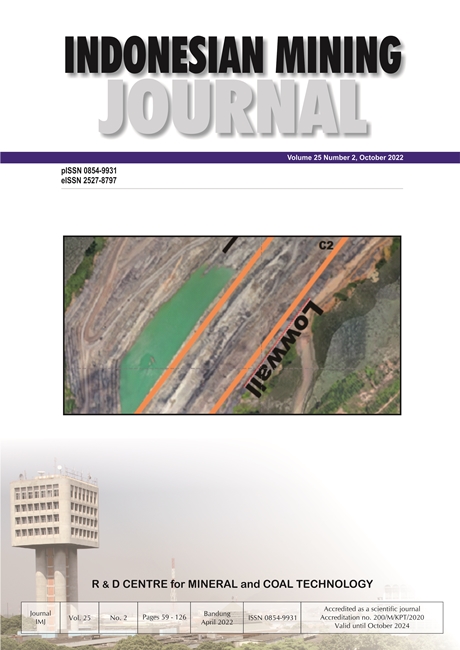GIS APPLICATION FOR MONITORING THE MINE AREAS
DOI:
https://doi.org/10.30556/imj.Vol25.No2.2022.1283Keywords:
geographical information system, satellite imagery, environmental monitoring, coal mineAbstract
Technology development is growing fast, such as satellite imagery and GIS for various applications, one of them is mining technology. Several regulations for the mining sector regarding the mandatory use of satellite imagery have been stated in some regulations to be implemented in mining sectors. Some mine environmental studies showed that the remote sensing and the GIS analysis could detect the small changes in its environment area with effective cost as the coverage of the sensory images is quite broad. The purpose is to monitor land alteration by observing the changes at the taking place, in either the number of voids or their area, using the 2019 and 2020 SPOT 6/7 image data. The algorithm change detection analyzes the number and void changing, mainly to provide a visual description of the void image trend and other applications. The trend of void numbers and its area can be predictable and correlated with the coal mine activities yearly. The results of 2019 SPOT 6/7 image showed that the total area of coal mine pit increased from 2% of the total area of the IUP to 2.53% in 2020. But, its allegation of environmental changes due to the mining activities will be strengthened by a ground check survey that cannot be conducted now.References
Abdollahnejad, A., Panagiotidis, D. and Bílek, L. (2019) ‘An integrated GIS and remote sensing approach for monitoring harvested areas from very high-resolution, low-cost satellite images’, Remote Sensing, 11(21), p. 2539. doi: 10.3390/rs11212539.
Arifin, S., Manalu, J., Kartika, T., Yulianto, F., Julzarika, A., Mukhoriyah, Sukowati, K. A. D. and Nugroho, G. (2020) ‘Metode pemantauan eksploitasi dan reklamasi tambang batubara menggunakan data Sentinel-2’, Jurnal Penginderaan Jauh dan Pengolahan Data Citra Digital, 17(2), pp. 123–133.
Fanani, Y. and Sari, A. S. (2018) ‘Pemanfaatan sistem informasi geografis untuk zonasi kawasan pertambangan Kabupaten Ngawi’, PROMINE, 6(2), pp. 24–30. doi: 10.33019/promine.v6i2.781.
Fenando, F. (2021) ‘Sistem informasi geografis (SIG) pemetaan lokasi pertambangan batu bara berbasis quantum GIS (Studi kasus: PT. Hasil Bumi Kalimantan)’, Journal of Information Systems and Informatics, 3(1), pp. 108–120. doi: 10.33557/journalisi.v3i1.94.
Gomez, O. F. (1997) Change Detection of Vegetation Using Landsat Imagery, www.crwr.utexas.edu. Available at: http://www.crwr.utexas.edu/gis/gishydro99/class/gomez/termproj.htm (Accessed: 7 January 2022).
Gong, P. (2001) Land cover and land use mapping and change dymanics modeling with remote sensing, nature-prod.cnd.berkeley.edu.
Available at: https://nature-prod.cnr.berkeley.edu/~penggong/textbook/ (Accessed: 7 January 2022).
Lutfi, M. and Antono, H. T. (2011) ‘Estimasi biomassa hutan sekunder dan daerah reklamasi menggunakan teknologi inderaja dan sistem informasi geografi’, Jurnal Teknologi Mineral dan Batubara, 7(2), pp. 54–62.
Mishra, S., Shrivastava, P. and Dhurvey, P. (2017) ‘Change detection techniques in remote sensing: A review’, International Journal of Wireless and Mobile Communication for Industrial Systems, 4(1), pp. 1–8. doi: 10.21742/ijwmcis.2017.4.1.01.
Nguyen, H.-H., Nghia, N. H., Nguyen, H. T. T., Le, A. T., Ngoc Tran, L. T., Duong, L. V. K., Bohm, S. and Furniss, M. J. (2020) ‘Classification methods for mapping mangrove extents and drivers of change in Thanh Hoa Province, Vietnam during 2005-2018’, Forest and Society, 4(1), pp. 225–242. doi: 10.24259/fs.v4i1.9295.
Nugroho, U. C., Kushardono, D. and Dewi, E. K. (2019) ‘Identifikasi kawasan pertambangan timah menggunakan data satelit sentinel – 1 dengan metode object based image analysis (OBIA)’, Jurnal Ilmu Lingkungan, 17(1), pp. 140–148. doi: 10.14710/jil.17.1.140-148.
Paull, D., Banks, G., Ballard, C. and Gillieson, D. (2006) ‘Monitoring the environmental impact of mining in remote locations through remotely sensed data’, Geocarto International, 21(1), pp. 33–42. doi: 10.1080/10106040608542372.
Research Systems Inc. (2004) ENVI user’s guide. Colorado: Research Systems Inc.
Shofiyanti, R. (2011) ‘Teknologi pesawat tanpa awak untuk pemetaan dan pemantauan tanaman dan lahan pertanian’, Informatika Pertanian, 20(2), pp. 58–64.
Suwarsono, Nf., Haryani, N. S., Prasasti, I., Fitriana, H. L., Priyatna, M. and Khomarudin, M. R. (2018) ‘Detecting the area damage due to coal mining activities using landsat multitemporal (Case study: Kutai Kartanegara, East Kalimantan)’, International Journal of Remote Sensing and Earth Sciences (IJReSES), 14(2), pp. 151–158. doi: 10.30536/j.ijreses.2017.v14.a2851.
Wibowo, A., Supriyantono, Y., Adenan, D. D., Sahminan, S. and Tanjung, A. F. A. (2005) ‘Pemantauan inderaja lingkungan S. Ajkwa, Papua menggunakan algoritma deteksi perubahan’, Jurnal Teknologi Mineral dan Batubara, 34(13), pp. 16–29.
Widiyatmoko, R., Wasis, B. and Prasetyo, L. B. (2017) ‘Analisis pertumbuhan tanaman revegetasi di lahan bekas tambang silika Holcim Educational Forest (HEF) Cibadak, Sukabumi’, Jurnal Pengelolaan Sumberdaya Alam dan Lingkungan (Journal of Natural Resources and Environmental Management), 7(1), pp. 79–88. doi: 10.29244/jpsl.7.1.79-88.
Downloads
Published
Issue
Section
License
Indonesian Mining Journal provides immediate open access to its content on the principle that making research freely available to the public to supports a greater global exchange of knowledge.

This work is licensed under a Creative Commons Attribution-NonCommercial 4.0 International License.













